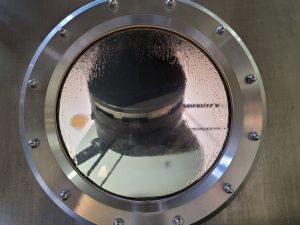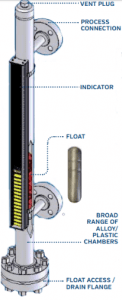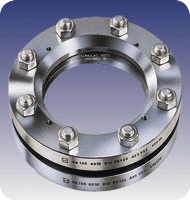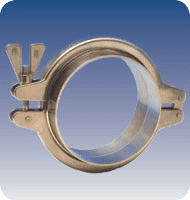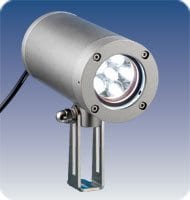
Explosion-proof process lighting solutions for industrial applications allow illumination in hazardous facility areas. Also referred to as EX lights, explosion-proof lights are suitable for illuminating processes in hazardous locations where combustible gases or vapors may be present, such as a critical processing line, pipeline, or vessel.
Plant managers know that you can’t control what you can’t see. That’s why sight glasses are installed throughout a system so that you can view what’s going on inside… but that isn’t enough. Without proper lighting, the interiors of your processing lines, vessels, and pipelines are often too dark for your operators to view critical process stages through a sight glass. Flashlights or other portable lights simply cannot provide sufficient lighting, and will often cause a glare to appear on the surface of the sight glass, making your visual inspections very difficult.
Without being able to see through your sight glass, the following could be happening without you knowing:
- Unbalanced fluid levels
- System blockage
- Pollution/contamination issues
- System or equipment leakage
- Vessel wall imperfections or damage
That’s why you need lights, or “luminaires”, to be able to effectively see through a sight glass, viewing window, or anywhere else throughout your system where high-quality lighting is needed. However, this isn’t a one size fits all scenario. You have to consider all of the properties of the light before choosing your process lightning. The type of technology, size and weight, wattage, voltage, materials, mounting configuration, color temperature, and distribution angle are all necessary factors of your selection. Heat and energy consumption, location requirements, and equipment/system vibration must be considered as well.
But your process lighting also needs to be able to handle the hazards of your application. Processes that take place in hazardous environments are often subject to explosive conditions. With just a single spark, your process lights can ignite an explosion. This can be dangerous to both your workers and facility, leading to possible injuries, costly damages, and unplanned downtime.

That’s why a better solution is needed for operations where there is a higher risk for an explosion. For these applications, explosion-proof lighting can provide an added degree of safety and security to your installations. Different lights will meet different standards set forth by the National Electric Code (NEC) Article 500.
It’s important to understand these ratings when picking your next lighting solution. How effective your lights will be at maintaining their integrity during operations will heavily depend on your specific processes. For instance, for lights with Class I ratings, the hazard level will depend on the frequency of occurrence. The longer a hazardous material or situation is present, the greater the risk to the light and your operations.
Beyond their explosion-proof capabilities, when choosing process lighting, you must also consider what technology you are using to generate light. Common types of lights seen across the industry include incandescent and halogen lights, LED lights, high-intensity discharge lights, and fiber optic lights.
While halogen and incandescent lights are among the most popular lights used in sight glass applications, they come with several drawbacks. Problems with these lights include:
- Low energy efficiency
- 2800 K temperature approximates dusk and causes eye fatigue
- Limited bulb life and easily damaged filaments
- A spherical light source that is difficult to capture and direct towards the operational field
With these disadvantages, more and more engineers are making the switch to other lighting solutions. LED lights offer a longer service life and are less prone to damage compared to their halogen/incandescent counterparts. Their smaller size and cold light output also add to their higher energy efficiency, making them perfect for energy-saving applications.
For applications where intense lighting is required, LED and high-intensity discharge (HID) explosion-proof process lights are among the brightest lights that the industry has to offer. With their ability to illuminate everything from the largest tanks or processes to the smallest sight glass windows, these lights can transmit light efficiently in almost any system.
When your mounting options are limited, fiber optic process lights can offer the high degree of flexibility that’s needed to illuminate tough to reach areas. Easily designed for cold light output, these lights can be mounted several feet away from vibrating equipment to help preserve bulb life. You can also use LED technology as the light source with fiber optic solutions.
No matter what type of explosion-proof process lighting you’re looking for, the engineers at L.J. Star have designed a number of solutions to fit all of your lighting needs. Every one of our lights has been tested across industry lines, guaranteeing their safety and efficiency among numerous applications.
By choosing L.J. Star, you’re choosing an engineering team that’s worked in the field and knows the problems you face… and how to solve them. That’s why all of our explosion-proof process lights are environmentally sealed and designed to prevent explosions by preventing a spark during operation. Our wide selection of options includes everything from traditional halogen lights to fiber optic and LED solutions.
Every explosion-proof light that we make meets the UL or ATEX requirements for the specific type of hazardous environment that lights will be operating in. All lights are made to be used with vessel sight glass view ports, dedicated light ports, and flow indicators so that you can see what’s going on within your systems and equipment.
Click here to learn more about product specs, lighting handbook, white papers, and other tutorial information on lighting.
